Short Interval Method: Reasonable Choice for Regular Colonoscopy
Hyunghun Kim*
Department of Gastroenterology, Division of Internal Medicine, Kangnam Peter’s Hospital, South Korea
Submission: September 11, 2017; Published: September 19, 2017
*Corresponding author: Hyunghun Kim, Department of Gastroenterology, Division of Internal Medicine, Kangnam Peter’s hospital, 2633 Nambusunhwan-ro, Gangnam-gu, Seoul, South Korea, Tel: +82-2-1544-7522 ; Fax: +82-2574-9414; Email: relyonlord@gmail.com
How to cite this article: HH Kim, Short Interval Method: Reasonable Choice for Regular Colonoscopy.. Adv Res Gastroentero Hepatol 2017; 7(2): 555708. DOI:10.19080/ARGH.2017.07.555708
Abstract
Long interval method, conventional cap attachment method, usually attaches a cap protruding about 5mm from the end of a colonoscope. This method provides a continuous visual field of the lumen direction, but has several disadvantages. The field of vision is affected by the cap. Feces or food remnant is easily impacted inside the cap causing black-out. Dirty water can come to the inside of the cap and prohibit clear observation. Finally, elongated forepart can cause trauma to the colonic mucosa, even perforation. Short interval method was developed to eliminate these disadvantages by attaching a cap protruding no more than 1mm from the end of a colonoscope. Short interval method provides continuous wide visual field of the lumen direction with markedly lowering the risk of fecal impaction, water filling, and mucosal trauma.
Keywords: Cap fitted colonoscopy; Cap; Colonoscopy; Short interval method
Abbreviation: CFC: Cap Fitted Colonoscopy; LIM: Long Interval Method; SIM: Short Interval Method
Introduction
The principle of cap fitted colonoscopy (CFC) is keeping the end of the colonoscope a distance away from the colonic mucosa, so CFC can prevent red out caused by attachment of colonic mucosa to the camera of the colonoscope. Consequently, CFC provides a continuous visual field of the lumen direction. Another important point of CFC is that least air insufflation is possible during colonoscopy. With the cap, colonoscopists can anticipate to which the colonoscope should be advanced with much less air insufflation than non-CFC, so CFC potentially enables a more comfortable examination with fast cecal intubation. A study revealed that the limited use of low-air insufflation in the rectum and sigmoid colon shortened the cecal intubation time and decreased post-procedural abdominal bloating [1]. For these reasons, CFC enables colonoscopists to achieve higher cecal intubation rate and shorter intubation time. Two metaanalyses studies demonstrated that higher cecal intubation rate was achieved with CFC than non-CFC [2,3]. Less-experienced colonoscopists could gain more benefit from CFC than experts [4]. However, experts showed a shorter cecal intubation time with CFC also [5]. Furthermore, CFC has shown faster cecal intubation in difficult situations, for example prior abdominal operation, old age, and poor bowel preparation [6].
Disadvantages of conventional cfc
Conventionally, CFC usually attaches a cap protruding about 5mm (Figure 1a). I would like to call this cap attachment method long interval method (LIM). LIM has several disadvantages. First, the field of vision is affected by the cap (Figure 1b). Colonoscopists should observe the colon through round opening of a cap compared the wide visual field of non-CFC. This method inevitably nARGHows the field of vision; roughly 18 % reduction compared to non-CFC (Figure 1b). Second, LIM provides a space for feces or food remnant to be impacted inside the cap. When there is fecal or food remnant impaction, colonoscopists cannot see anything because the camera of the colonoscope is covered by feces or food remnant (Figure 1c). In this situation, an assistant should inject water through a channel to resolve this problem; repeated bothersome activity. Additionally, dirty water can come to the inside of the cap and prohibit clear observation (Figure 1d). Finally, the elongated forepart can cause trauma to the colon mucosa, even perforation.
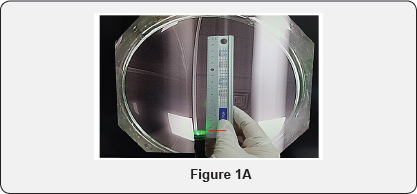
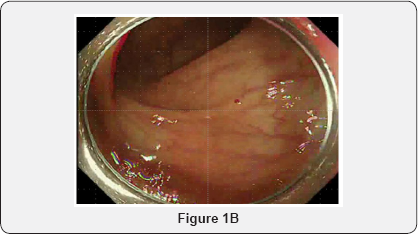
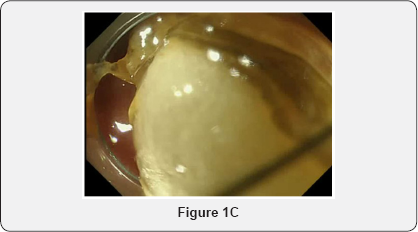
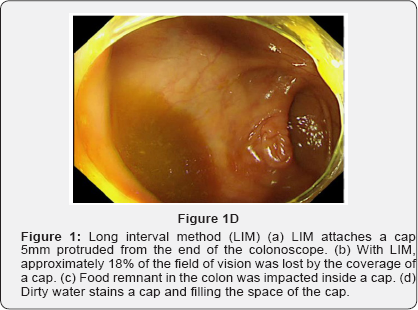
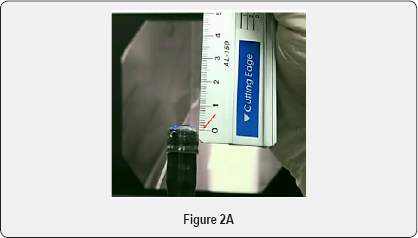

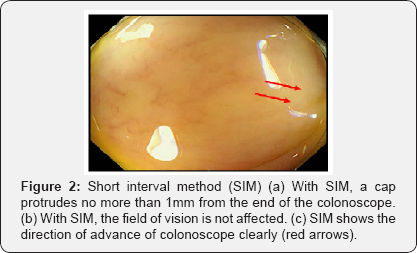
Short interval method
To eliminate these disadvantages, short interval method (SIM) was devised [7]. The gist of SIM is the short interval between the end of the endoscope and the end of the cap. When the interval is no more than 1mm (Figure 2a), the field of vision is rarely affected; same to the field of vision of non-CFC (Figure 2b). Cap protrusion of no more than 1mm length provides nearly no space, so feces cannot be impacted, and water cannot be filled easily. About 1mm elongation of the forepart of the colonoscope rarely causes
mucosal trauma when a colonoscope rotates. SIM maintains the most important advantage of CFC. SIM provides a continuous visual field of the lumen direction (Figure 2c). Therefore, SIM makes advanced colonoscopy techniques performed more easily by obtaining continuous wide visual field and eliminating the disadvantages of LIM. The union of SIM and slalom technique, SIM-slalom technique, produces easy and faster cecal intubation due to non-blind advance through folds (Figure 3) [7]. The union of SIM and sliding technique, SIM-sliding technique, also shows high performance when a colonoscope passes through seriously twisted or bending segments (Figure 4) [7].
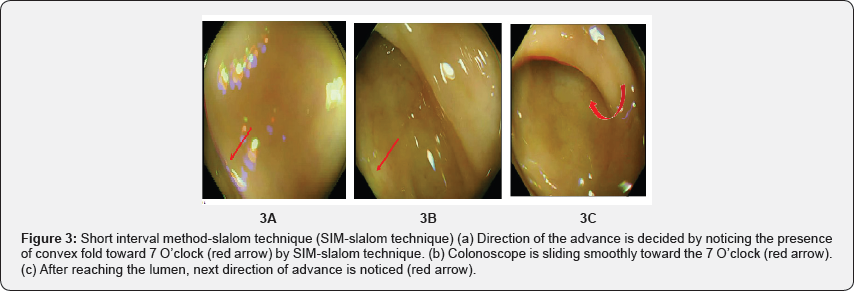


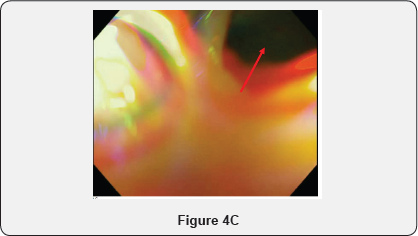

Conclusion
There are a few ways to use caps for regular colonoscopy or special procedures. The interval between the end of the cap and the end of the colonoscope is a decisive factor for acquiring the specific purpose of the usage of a cap in each procedure. SIM appears to be a reasonable choice for regular colonoscopy because of the continuous visual field of the lumen direction, wide field of vision: same to that of non-CFC, nearly no fecal impaction and no water filling, and markedly low probability of mucosal trauma.
References
- Hsieh YH, Tseng KC, Lin HJ (2010] Limited low-air insufflation is optimal for colonoscopy. Dig Dis Sci 55(7]: 2035-2042.
- He Q, Li JD, An SL, Liu SD, Xiao B, et al. (2013] Cap-assisted colonoscopy versus conventional colonoscopy: systematic review and metaanalysis. Int J Colorectal Dis 28(2]: 279-281.
- Westwood DA, Alexakis N, Connor SJ (2012] Transparent cap-assisted colonoscopy versus standard adult colonoscopy: a systematic review and meta-analysis. Dis Colon Rectum 55(2]: 218-225.
- Kondo S, Yamaji Y, Watabe H, Yamada A, Sugimoto T, et al. A randomized controlled trial evaluating the usefulness of a transparent hood attached to the tip of the colonoscope. Am J Gastroenterol 102(1): 7581.
- Ng SC, Tsoi KK, Hirai HW, Lee YT, Wu JC, et al. (2012) The efficacy of cap-assisted colonoscopy in polyp detection and cecal intubation: a meta-analysis of randomized controlled trials. Am J Gastroenterol 107(8): 1165-1173.
- Kim HH, Park SJ, Park MI, Moon W, Kim SE (2012) Transparent-cap- fitted colonoscopy shows higher performance with cecal intubation time in difficult cases. World J Gastroenterol 18(16): 1953-1958.
- https://youtu.be/alv-oh23lCl






























